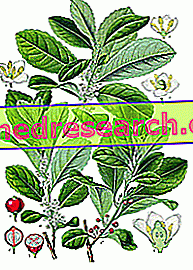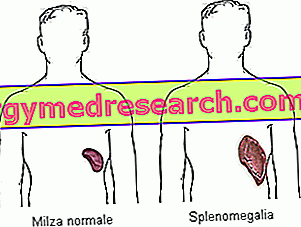Generality
The mate - also known as Paraguayan tea - is the infusion prepared with the green or toasted leaves of an evergreen holly, which grows wild in Argentina, Brazil, Paraguay and Uruguay. This shrub is known in botany with the binomial nomenclature Ilex paraguariensis .

Photo: Detail of leaves of Ilex paraguariensis
In Spanish-speaking countries, the infusion is known as yerba matè and represents the traditional colonial drink par excellence, highly appreciated as a stimulating drink. Alternative names of the drink are " Tea of Paraguay " or " Tea of the Jesuits ", as they are responsible for the spread of the plant in Europe.
It is estimated that more than 1 million yerba mate consumers worldwide are concentrated mainly in the states of South America.
The flavor of the infusion is astringent (tannic) and bitter; the scent is characteristic and aromatic.
Part used
For the production of the mate the terminal parts of the twigs are cut off and exposed to heat to inactivate the enzymes; in this way it is possible to preserve the green color of the leaves, which are then dried and broken up, then used to prepare infusions. Roasting, albeit mild, is also important for the development of aromatic substances that give the infusion its organoleptic characteristics.

Photo: Dried mate leaves in wooden bowl, with relative infusion in traditional container with spout (bombilla).
Discover the recipe to prepare Matè in Casa
Active principles

Thanks to the abundant presence of this substance, the infusion is traditionally consumed as a tonic, cardiotonic and rebalancing; in South American folk medicine it is also used in the treatment of headaches, digestive problems, rheumatism and obesity.
Just the "fat-burning" effect due to the presence of caffeine is greatly amplified by the marketing campaigns, which depict the mate as the "ideal slimming", an excellent natural remedy to lose weight. In fact, the caffeine dose is not that important and its "slimming" effect would be supported by phenolic compounds and chlorogenic acid. In any case, the amount of studies on this subject is extremely limited.
Caffeine content
The caffeine content of Ilex paraguariensis leaves is around 1% (0.2-2%), even if only a small percentage is extracted during the preparation of the drink. In infusion the average caffeine content is about half of that found in a similar quantity of coffee.
As for tea, caffeine is also concentrated in young leaves, not yet disclosed, and tends to decrease with preservation.
The following table summarizes the average caffeine content of various medicinal plants, including maté.
| Plant (drink) | Part of the plant | Caffeine content (ppm) |
| Camellia sinensis (Tea) | Leaf | 3810-93000 |
| Paullinia cupana (Guarana) | Seed | 25000-76000 |
| Coffea arabica (Coffee) | Seed | 600-32000 |
| Paullinia yoko (Yoko) | Bark | 3000-27300 |
| Cola accuminata (Cola) | Seed | 10000-25000 |
| Ilex paraguariensis (Matè) | Leaf | 2000-20000 |
| Theobroma cacao (Chocolate) | Seed | 500-12900 |
| Theobroma bicolor (Chocolate) | Fruit | 158-184 |
| Citrus limon (Lemonade) | Flower | 0.5-50 |
| Citrus sinensis (Orange Soda) | Leaf | 0.4-0.6 |
Composition in Active Principles
Reducing the properties of the mate to the mere presence of caffeine is at least reductive.
The maté, in fact, contains;
- purine alkaloids: the main ones are caffeine (0.4-2.4%) and theobromine (0.3-0.5%);
- caffeic acid derivatives: including, among others, chlorogenic acid (mate is one of the main sources of this antioxidant), neochlorogenic acid and cryptochlorogenic acid;
- flavonoids: including, among others, rutin, isoquercitin and kampferolic glycosides;
- triterpene saponins;
- Volatile oil.
Moreover, mate is also:
- a good source of vitamin C (however greatly reduced with drying and preservation);
- rich in protein;
- rich in minerals such as potassium, zinc, manganese, magnesium, calcium and iron.
Dried, powdered or not, is recommended for athletes and as an adjunct in slimming diets. In the latter case, in addition to the lipolytic activity of caffeine, the diuretic activity of the product is also exploited, which can be useful to combat water retention (a "problem" particularly felt by those who wish to lose weight).
Medicinal properties
Among the properties attributable to the mate on the basis of its chemical profile are those:
- tonics → helps fight fatigue, increasing physical energy and a sense of vigor
- stimulants → supports memory and improves attention, helps to improve mood, improves heart contractility (positive inotropic and chronotropic effects)
- diuretiche → stimulates diuresis, favoring the elimination of excess fluids in the event of water retention
- lipolytic and hypocholesterolemizing → caffeine stimulates the mobilization of fatty acids from adipose tissue and promotes oxidation for energy purposes; some flavonoids and phenolic acids present in the mate inhibit pancreatic lipase and lipoprotein lipase enzymes; the high content of chlorogenic acid could help reduce cholesterol levels in the blood, hinder adipogenesis and reduce post-prandial glycemic peaks;
- anorectics → reduces appetite
- antioxidants
Watch the video
X Watch the video on youtubeNOTE: the number of studies on mate is in any case extremely limited and mostly limited to experimental models (in vitro) and animals, which is why the aforementioned properties remain suppositions awaiting practical demonstration.
In a recent randomized, double-blind, placebo-controlled clinical trial, the administration of 3g of mate per day (standardized in 3.5% chlorogenic acid), divided into 3 intakes, for 12 weeks, significantly reduced the mass fat and abdominal circumference of a group of 15 Korean obese subjects [Anti-obesity effects of Yerba Mate (Ilex Paraguariensis): a randomized, double-blind, placebo-controlled clinical trial - BMC Complement Altern Med. 2015 Sep 25; 15: 338]
Approved jobs
The German Commission approves the use of the mate to combat lack of vigor and psycho-physical fatigue.
Uses not confirmed
Note: the utility in the following circumstances has not been confirmed by experimental tests, conducted with scientific method, or has not exceeded them. The use of mate to treat the following disorders could therefore be ineffective or even harmful.
Popular medicine uses the mate for internal use also to fight ulcers, rheumatism, anemia, neurasthenia, depression, as a diuretic in the case of oliguria and as a prevention against fever and infections; externally the leaf mush is used against ulcers and inflammation.
In homeopathy, Ilex paraguariensis is used to combat poor digestion.
Mode of use
The mate is available in the form of
- Dried and shredded leaves, indicated as herbal rinedio for herbal teas or in filter sachets:
- the recommended dose is 2-4g (divided into 3 infusions to be taken at different times of the day).
Preparation: pour a cup of boiling water on the preparation and leave to infuse for 5-10 minutes, then filter and drink.
Notes: A short infusion is less astringent, has a better taste and still retains a good stimulating capacity (since caffeine is extracted faster than tannins).
- the recommended dose is 2-4g (divided into 3 infusions to be taken at different times of the day).
- dry extracts obtained from the leaves and titrated in caffeine or in chlorogenic acid; they are the best choice for prolonged treatments. Generally available as tablets or capsules; we recommend taking 3g divided into 2 or 3 hires.
Contraindications
In literature, there are no significant side effects; unlike other caffeine-rich drugs, the mate would also seem to have no negative effects on insomnia.
The regular consumption of infusions of boiling mate (as well as any other hot drink) is considered a risk factor for the development of oral cancer, laryngeal, esophagus and squamous cell carcinoma of the head and neck.
The intake of mate is contraindicated for those suffering from hypertension, heart disease, diabetes, gastric or duodenal ulcers and hyperthyroidism.
People being treated with MAO inhibitors (drugs used to treat depression) should be treated with caution.



